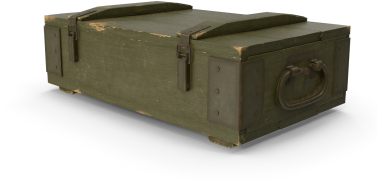The division had just completed the reduction of Bayreuth on April 15th 1945. Prior to that time and after a brief, uneventful attachment to the 7th US Army it came under the operational control of XII Corps and crossed the Rhine River at Oppenheim on the 30th of March 1945 in a purely administrative move. The 71st Infantry Division was then ordered southeast from its assembly area in the vicinity of Hanau to follow behind the 26th Infantry Division which was trying to keep pace with the 11th Armored Division in its drive southeast.
The rapid advance of the 3rd Army had brought its forward elements well in advance of the 7th Army and the right flank of XII Corps was exposed. The 71st Iwas given the mission of protecting this exposed flank. While staging forward prior to assuming designated positions, the division was notified of an unknown number of German troops operating in the rear of the XII Corps zone which had been bypassed in the rapid advance southeast. The 71st Reconnaissance Troop was sent to investigate and became involved with superior numbers. The 66th Infantry Regiment was then committed. It too reported numerous enemies and upon identification of the 6th SS Mountain Division as the opposition, the entire outfit was committed and in a brief but intense fight 4000 prisoners were captured and the 6th SS Mountain Division eliminated from the German Order of Battle.

Priosners were careful to keep their hands up
While in position as right flank guard for XII Corps it received the mission of relieving the 11th Armored Division on the outskirts of Bayreuth. The enemy put up merely token resistance in front of the city. The 14th Infantry Regiment passed through the 11th Armored Division and entered the city on April 14th . The town was securely in the hands of the 71st Infantry Division on the 15th of April and the autobahn north of Bayreuth had been out. Considerable confusion then ensued caused by a change of Corps assignments and a sudden shift in directions of attack for the 3rd and 7th Armies.
On April 17th, the division was transfered into the XX Corps. XX Corps had just completed an administrative move south to Bamberg from Weimar with the 80th Infantry Division where it had left the 76th Inf and the 4th and 6th Armored Division around Chemnitz. The new plan of 3rd Army called for an advance southeast on an axis of Regensberg-Linz to make contact with the Russians advancing from Vienna. The 3rd Army would advance with three Corps abreast, the XII on the left, XX Corps in the centre and III Corps on the right. The XX Corps with the 71st and the 65th Infantry Divisions, the 80th Infantry Divisions and the 13th Armored Division planned to advance on the designated axis of advance with the 71st on the left and the 65th Infantry Division on the right and keep the 80th and 13th Armored Division in reserve. This attack was to be undertaken when Nuremberg had fallen to XV Corps of the 7th Army.
XX Corps would then assume command of the zone of advance previously held by XV Corps and the line of departure was established as the road from Ambrg to Nuremberg. Until Nuremberg fell XV Corps would retain operational control over the area and the movement of troops would be on XV Corps orders. The XV Corps became involved in bitter fighting in Nuremberg and was forced to concentrate its divisions in and around the city. The 14th Armored Division, which was at the northeast of the city, was withdrawn on the 7th Army order and thus left a gap in depth existing between the embattled divisions of XV Corps and XII Corps on the north.

The dining room of Goering's castle near Neuhaus
The 71st which was in position behind the 14th Armored was the logical one to take over the closing of this gap. Accordingly, the 71st Infantry Division initially received orders from XII Corps on the 17th of April to attack southeast, destroy all enemy in zone and cut the Sulzzbach-Nuremberg highway. As it was to operate in XV Corps zone until Nuremberg had fallen and thereafter come under the control of XX Corps, no boundaries were assigned.
The plan was therefore conceived to initially commit two regiments, the 14th and 66th Infantry Regiments and as the zone widened the 5th Infantry Regiment would be committed in the centre until it took Amberg where again the zone narrowed down. The line of departure for XX Corps would then have been secured and the 65th Infantry Division would be committed on the right. At this point the 14th Infantry Regiment would be squeezed out by the 5th Regiment. A plan for relieving regiments on the line so that one regiment would get some rest periodically was devised in advance of the coming operation which was anticipated to be lengthy and arduous involving a pursuit over mountainous and heavily wooded terrain as well as crossing the Isar, Danube, Vili, Inn, Traunn and Enns Rivers.

Scenes of the Danube crossings
The 5th Infantry Regiment accordingly pivoted on Bayreuth and extended itself along the left flank of the division while the 14th on the left and the 66th on the right or south flank took over positions of the 14th Armored in the general vicinity of the town of Trockau on April 17th.

The Red Circle route in its smsh from Bayreuth across the Danube River
On the 18th of April the two regiments cleared the heavy woods to their front. The 5th was then committed in the centre and as it had no wooded area to clear, was able to push ahead of the two flanks and reach Nasnitz by nightfall on the 19th of April while the 14th on its left advanced to the towns of Thurndorf and Troschnreuthwith the aid of the 2nd Battalion of the 5th Infantry Regiment which helped it in the mall arms fight around the outskirts of the latter town. The 66th Infantry Regiment on the right had cleared the heavily wooded areas in its zone and was extended from Brona to Nemshenreuth along the edge of another forest.
Written by Pierre Fallet

















